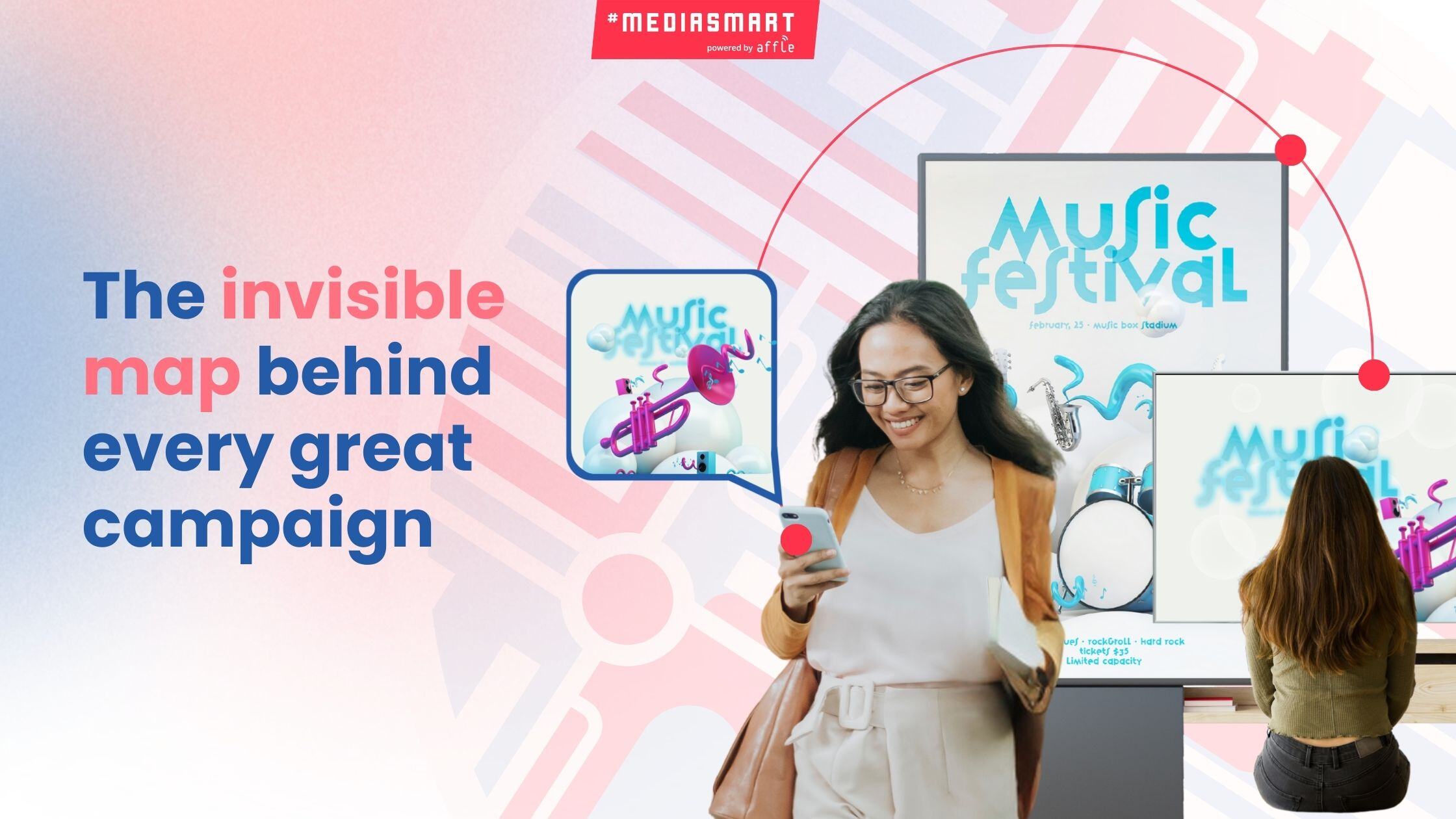Blog
Announcements, analysis and opinions on industry trends around the mobile programmatic world.

Subscribe now, and receive the latest programmatic content directly on your inbox!
Thank you for subscribing to our newsletter
How location intelligence fuels smarter advertising
Ever feel like some brands just know when to pop up at the right time? Like you're walking by a store and boom, there’s an ad for it on your phone. That’s not magic. That’s location intelligence.
Every time you step into a shop, pause near a café, or stroll past a billboard, you're creating signals: generating little digital breadcrumbs. These aren’t just random data points; they’re clues to what you like and where you’re headed. Marketers who know how to read that map? They don’t just guess; they win. But Location intelligence isn’t about following people around, it’s about understanding context. In advertising, context is king. Let’s break it down.
What is location intelligence?
Location intelligence is what happens when raw location data gets a glow-up. It pulls from sources like GPS locations, Wi-Fi signals, from Mobile, CTV, and DOOH screens and then uses that geospatial data to understand consumer behavior and optimize marketing strategies across physical and digital touchpoints.
Platforms like mediasmart take this raw data and turn it into something useful: maps for targeting (geolists), Offline sync (drive-to-store measurement), or DOOH Audience Sync, among others. All the good stuff that helps you connect the dots between context, impression, and action. Combined with dynamic creative optimization, it enables personalized, location-aware ads that drive both engagement and foot traffic.
From static maps to smart paths: the evolution of location in marketing
Old-school location-based marketing? It was all about zip codes, city-wide media buys, and hoping for the best. And hey, we’re not saying it didn’t work. Some traditional campaigns were iconic. Take Las Vegas in 2003. With just seven words, “What Happens Here, Stays Here” turned a destination into a mindset. It didn’t just advertise a place; the campaign became a cultural phenomenon, inspiring films, music, and one of the most memorable brand identities in history.
Back in the day, Las Vegas had one line, and it stuck. One message, everywhere. It worked because it felt like a secret between you and the city. Now, imagine if that secret could change depending on where your users were. At the airport? “Still time to do something unforgettable.” Near the hotel spa? “No one back home needs to know about this massage.” That’s location intelligence. It's like your campaign got a sense of direction and maybe a cheeky personality to match.
Advertisers nowadays have dynamic maps. Not the kind you fold up. These are digital heatmaps of where people go. That shift from geodemographics to movement patterns is a game-changer. Instead of guessing where your audience might be, you know where they’re showing up and can meet them there, in real time. That’s the sweet spot: context + timing + message = smart ads.
The 3 key benefits of location intelligence
From hidden hotspots to real-world foot traffic and smarter geo-activation, this is how you turn location intelligence into real marketing results, with less waste and more impact.

1. Reveal hidden audience clusters
Here’s the premise: your best customers might not be where you think they are. You thought it was the city center, but it turns out it is that one strip of cute cafés and gyms people flock to every morning.
With mediasmart’s Geolists, you can zero in on the hotspots that matter and let our algorithms do the heavy lifting in real time. Optimize toward the best-performing areas.
Whether it's near competitors, buzzing retail zones, or even a weekend pop-up event, you’re always targeting where it counts. And the best part? No extra cost to create or activate them.
2. Sync online and offline behavior
Click-throughs are cool, but did your ad get someone to show up? It’s one thing to know someone saw your ad. It’s another to know they showed up on your front step.
Run a drive-to-store campaign, show an ad on CTV, and then track if the viewer later visited your physical location, store, restaurant, or hotel. Whether they walked in after watching from the couch or passed by after seeing your mobile ad, you get real insights into how online attention turns into offline action. That is footfall attribution. mediasmart connects those dots so you can see which locations and creatives drove visits and which didn’t.
3. Target smarter, waste less
Why shout your message into the void when you can aim with precision? Geo-targeting lets you reach people exactly where it matters: near your store, around your competitors, or in key high-traffic zones. Someone walks past your shop? Hit them with a timely promo. Is a lead chilling at home a week after their first visit? Nudge them with a reminder they won’t ignore.
And for brand-first formats like DOOH, location intelligence turns static screens into part of a smarter journey. A person sees your billboard during their morning run. Later, they get a personalized offer on their phone. That’s mediasmart’s DOOH Audience Sync doing what it does best: connecting the dots between the real world and the digital one. Align your campaign with your goals and make every cent count.
Location intelligence makes sure your ads talk to each other across channels, screens, and even real-world actions. Whether you’re starting online or offline, everything stays connected.
How to read the invisible map: building hyper-local campaigns with location data

Map your key zones
Start with what you know: your store locations, your competitors, that place everyone’s going to this weekend. Geolists lets you build and activate those zones directly in mediasmart; no guesswork.
Create location-aware personas
Not all shoppers are created equal. Some commute. Some browse. Some show up like clockwork. Build Location-based segments based on how people move, where they pause, and when they return.
So, instead of targeting “women aged 30–45,” you’re reaching “morning commuters who grab coffee and shop on Saturdays.” It’s timely, relevant, and built for today’s expectations, because - according to this Deloitte report - 71% of consumers now expect personalized experiences when they shop.
Customize your ads in real time
This is where ads meet context.
Use Dynamic creative optimization and location to show relevant, timely messages: a map to the nearest store, a flash deal for people nearby, or different CTAs depending on the time of day or proximity. Example: someone walking by? “You're 200m from 20% off.” Someone relaxing at home after their visit? “Thanks for stopping by. Here is something extra for next time.”
You can take it a step further by adding real-time weather data into the mix. Tailor your ads to match the moment. Sunny skies? Serve sunglasses. Rain on the way? Time to promote indoor activities. With weather-triggered campaigns, your ads make sense the second they show up.
Add interactive power to your creatives with embedded maps and click-to-map URLs that guide users straight to your store or campaign destination. Turn interest into real-world action with a single tap.
Sync across screens
Your customers don’t live frozen in place, looking at a single screen, and neither should your strategy.
They’re checking their phone in a café, walking past a billboard on the way home, then watching CTV on the couch. Location ties it all together. It tells you where they are, what they’re near, and when to show up.
For example, Location-based audiences enable you to re-engage users who’ve already visited your store or even your competitors’. DOOH Audience Sync creates seamless messaging between what someone sees on the street and what follows them to their phone.
With the right omnichannel setup, location data becomes your glue, keeping your message consistent whether they’re scrolling, strolling, or streaming. It is how you keep your brand top-of-mind, and consistent across every screen.
Track movement and performance
So, the campaign’s out in the wild, powered by location. Now what?
You don’t just sit back and hope it works. You “check the map”, mediasmart lets you see who showed up. You’ll know which zones got people moving, which creatives hit home, and where things fell flat using our drive-to-store solution. Deloitte’s ‘The rise of spatial thinking’ claims that brands that used location-based advertising saw in-store conversions increase by as much as 20%.
It’s like having a report card for your real-world impact. Then? Our system optimizes in real-time, you test some more, and next time, you hit even harder. No guesswork, just smart moves based on what happened.
Case study: Glenfiddich in the spotlight
In the heart of the Scottish Highlands, Glenfiddich has long stood for more than just whisky, it’s a legacy of craftsmanship, bold thinking, and innovation. Ever wonder how a luxury whisky finds the right crowd in a sea of noise?
Glenfiddich teamed up with mediasmart and DDB Mudra, using location intelligence to map premium zones: golf courses, high-end malls, and fine dining spots. By mapping those exclusive zones and using precision targeting, the campaign delivered bold storytelling right where it mattered.
The result? Tradition met tech, and whisky met the future.
That’s how you raise the bar.
Smart wrap-up: Stop guessing. Start mapping
Smart campaigns don’t just reach people; they meet them in the right place, at the right time, with the right message.
That’s the power of location intelligence: it turns real-world behavior into real-time strategy. And with mediasmart, you’re not just reacting to where your audience is; you’re planning around it.
From dynamic maps to interactive creatives and seamless screen-to-store journeys, you’re turning data into decisions and impressions into foot traffic.
The map is there. Now it’s your move.
Read more about Location intelligence and privacy concerns, stats and trends, or how to maximize shopping seasons with it.
Sources
Geospatial Analytics use cases | Deloitte Insights
Unlocking Value with Location Intelligence | BCG
LVCVA
Topics: footfall, Geolocation, hyperlocation, location intelligence in advertising, hyper-local targeting, geospatial, Location, location-based marketing, geolists, geo-targeting advertising, dynamic creative optimization, DCO, spatial audience targeting, location-based audiences, hyper-local campaigns
%20(1).jpg)

